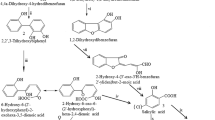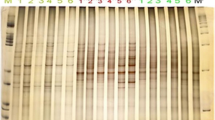Abstract
Contaminated sites in Lagos, Nigeria were screened for the presence of chlorobiphenyl-degrading bacteria. The technique of continual enrichment on Askarel fluid yielded bacterial isolates able to utilize dichlorobiphenyls (diCBs) as growth substrates and six were selected for further studies. Phenotypic typing and 16S rDNA analysis classified these organisms as species of Enterobacter, Ralstonia and Pseudomonas. All the strains readily utilized a broad spectrum of xenobiotics as sole sources of carbon and energy. Growth was observed on all monochlorobiphenyls (CBs), 2,2′-, 2,3-, 2,4′-, 3,3′- and 3,5-diCB as well as di- and trichlorobenzenes Growth was also sustainable on Askarel electrical transformer fluid and Aroclor 1221. Time-course studies using 100 ppm of 2-, 3- or 4-CB resulted in rapid exponential increases in cell numbers and CB transformation to respective chlorobenzoates (CBAs) within 70 h. Significant amounts of chloride were recovered in culture media of cells incubated with 2-CB and 3-CB, suggesting susceptibilities of both 2- and 3-chlorophenyl rings to attack, while the 4-CB was stoichiometrically transformed to 4-CBA. Extensive degradation of most of the congeners in Aroclor 1221 was observed when isolates were cultivated with the mixture as a sole carbon source. Aroclor 1221 was depleted by a minimum of 51% and maximum of 71%. Substantial amounts of chloride eliminated from the mixture ranged between 15 and 43%. These results suggest that some contaminated soils in the tropics may contain exotic micro-organisms whose abilities and potentials are previously unknown. An understanding of these novel strains therefore, may help answer questions about the microbial degradation of polychlorinated biphenyls (PCBs) in natural systems and enhance the potential use of bioremediation as an effective tool for cleanup of PCB-contaminated soils.




Similar content being viewed by others
References
Abramowicz DA (1990) Aerobic and anaerobic biodegradation of PCBs: a review. Crit Rev Biotechnol 10:241–251
Adebusoye SA, Picardal FW, Ilori MO, Amund OO, Fuqua C, Grindle N (2007) Aerobic degradation of di-and trichlorobenzenes by two bacteria isolated from polluted tropical soils. Chemosphere 66:1939–1946
Ahmad D, Masse R, Sylvestre M (1990) Cloning and expression of genes involved in 4-chlorobiphenyl transformation by Pseudomonas testosteroni: homology to polychlorobiphenyl degrading genes in other bacteria. Gene 86:53–61
Ahmed M, Focht DD (1973) Degradation of polychlorinated biphenyls by two species of Archromobacter. Can J Microbiol 19:47–52
Aislabie JM, Richards NK, Boul HL (1997) Microbial degradation of DDT and its residues: a review. N Z J Agric Res 40:269–282
Arensdorf JJ, Focht DD (1994) Formation of chlorocatechol meta cleavage products by a pseudomonad during metabolism of monochlorobiphenyls. Appl Environ Microbiol 60:2884–2889
Arensdorf JJ, Focht DD (1995) A meta cleavage pathway for 4-chlorobenzoate, an intermediate in the metabolism of 4-chlorobiphenyl by Pseudomonas cepacia P166. Appl Environ Microbiol 61:443–447
Barton MR, Crawford RL (1988) Novel biotransformation of 4-chlorobiphenyl by a Pseudomonas sp. Appl Environ Microbiol 54:594–595
Bedard DL, Haberl ML, May RJ, Brennan MJ (1987a) Evidence for novel mechanisms of polychlorinated biphenyl metabolism in Alcaligenes eutrophus H850. Appl Environ Microbiol 53:1103–1112
Bedard DL, Wagner RE, Brennan MJ, Haberl ML, Brown JF (1987b) Extensive degradation of Aroclors and environmentally transformed polychlorinated biphenyls by Alcaligenes eutrophus H850. Appl Environ Microbiol 53:1094–1102
Bevinakatti BG, Ninnekar HZ (1993) Biodegradation of 4-chlorobiphenyl by Micrococcus species. World J Microbiol Biotechnol 9:607–608
Bopp L (1986) Degradation of highly chlorinated PCBs by Pseudomonas strain LB400. J Ind Microbiol 1:23–29
Bruhlmann F, Chen W (1999) Transformation of polychlorinated biphenyls by a novel BphA variant through the meta-cleavage pathway. FEMS Microbiol Lett 179:203–208
Cole JR, Chai B, Farris RJ, Wang Q, Kulam-Syed-Mohideen AS, McGarrell DM, Bandela AM, Cardenas E, Garrity GM, Tiedje JM (2007) The ribosomal database project (RDP-II): introducing myRDP space and quality controlled public data. Nucleic Acids Res 2007 35(Database issue):D169–D172
Commandeur LCM, Parsons JR (1990) Degradation of halogenated aromatic compounds. Biodegradation 1:207–220
Commandeur LCM, May RJ, Mokross H, Bedard DL, Reineke W, Govers HAJ, Parsons JR (1996) Aerobic degradation of polychlorinated biphenyls by Alcaligenes sp. JB1: metabolites and enzymes. Biodegradation 7:435–443
Dorn E, Hellwig M, Reineke W, Knackmuss H-J (1974) Isolation and characterization of a 3-chlorobenzoate degrading pseudomonad. Arch Microbiol 99:61–70
Fava F, Marchetti L (1991) Degradation and mineralization of 3-chlorobiphenyl by a mixed aerobic bacterial culture. Appl Microbiol Biotechnol 36:240–245
Furukawa K, Chakrabarty AM (1982) Involvement of plasmids in total degradation of polychlorinated biphenyls. Appl Environ Microbiol 44:619–626
Furukawa K, Tomizuka N, Kamibayashi A (1979) Effect of chlorine substitution on the bacterial metabolism of various polychlorinated biphenyls. Appl Environ Microbiol 38:301–310
Haller HD, Finn RK (1979) Biodegradation of 3-chlorobenzoate and formation of black color in the presence and absence of benzoate. Eur J Appl Microbiol Biotechnol 8:191–205
Hernandez BS, Arensdorf JJ, Focht DD (1995) Catabolic characteristics of biphenyl-utilizing isolates which cometabolize PCBs. Biodegradation 6:75–82
Hickey WJ, Brenner V, Focht DD (1992) Mineralization of 2-chloro- and 2,5-dichlorobiphenyl by Pseudomonas sp. strain UCR2. FEMS Microbiol Lett 98:175–180
Juhasz AL, Naidu R (2000) Enrichment and isolation of non-specific aromatic degraders from unique uncontaminated (plant and faecal material) sources and contaminated soils. J Appl Microbiol 89:642–650
Kepner J, Raymond L, Pratt JR (1994) Use of fluorochromes for direct enumeration of total bacteria in environmental samples: past and present. Microbiol Rev 58:603–615
Kim S, Picardal F (2000) A novel bacterium that utilizes monochlorobiphenyls and 4-chlorobenzoate as growth substrates. FEMS Microbiol Lett 185:225–229
Kim S, Picardal F (2001) Microbial growth on dichlorobiphenyls chlorinated on both rings as a sole carbon and energy source. Appl Environ Microbiol 76:1953–1955
Knackmuss H-J (1984) Biochemistry and practical implications of organohalide degradation. In: Klug MJ, Reddy CA (eds) Current perspectives in microbial ecology. American Society for Microbiology, Washington, DC, pp 687–693
Kobayashi K, Katayama-Hirayama K, Tobita S (1996) Isolation and characterization of microorganisms that degrade 4-chlorobiphenyl to 4-chlorobenzoic acid. J Gen Appl Microbiol 42:401–410
Marks TS, Smith ARW, Quirk AV (1984) Degradation of 4-chlorobenzoic acid by Arthrobacter sp. Appl Environ Microbiol 48:1020–1025
McCullar MV, Brenner V, Adams RH, Focht DD (1994) Construction of a novel polychlorinated biphenyl-degrading bacterium: utilization of 3,4′-dichlorobiphenyl by Pseudomonas acidovorans M3GY. Appl Environ Microbiol 60:3883–3889
Mondello F (1989) Cloning and expression in Escherichia coli of Pseudomonas strain LB400 genes encoding polychlorinated biphenyl degradation. J Bacteriol 171:1725–1732
Omori T, Sugimura K, Ishigooka H, Minoda Y (1986) Purification and some properties of a 2-hydroxy-6-oxo-6-phenylhexa-2,4-dienoic acid (HOPDA) reducing enzyme from Pseudomonas crucivae S93 B1 involved in the degradation of biphenyl. Agric Biol Chem 50:931–937
Pellizari VH, Bezborodnikov S, Quensen JF III, Tiedje JM (1996) Evaluation of strains isolated by growth on naphthalene and biphenyl for hybridization of genes for dioxygenase probes and polychlorinated biphenyl-degrading ability. Appl Environ Microbiol 62:2053–2058
Potrawfke T, Lohnert T-H, Timmis KN, Wittich R-M (1998) Mineralization of low-chlorinated biphenyls by Burkholderia sp. strain LB400 and by a two-membered consortium upon directed interspecies transfer of chlorocatechol pathway genes. Appl Microbiol Biotechnol 50:440–446
Rodrigues JLM, Kachel CA, Aiello MR, Quensen JF, Maltseva OV, Tsoi TV, Tiedje JM (2006) Degradation of Aroclor 1242 dechlorination production products in sediments by Burkholderia xenovorans LB400(ohb) and Rhodococcus sp. strain RHA1(fcb). Appl Environ Microbiol 72:2476–2482
Suenaga H, Goto M, Furukawa K (2001) Emergence of multifunctional oxygenase activities by priming recombination. J Biol Chem 276:22500–22506
Acknowledgements
Authors would like to acknowledge the financial support of the ICSC-World Laboratory, Lausanne, Switzerland and the School of Public and Environmental Affairs, Indiana University, Bloomington, IN, USA. We thank Nathan Grindle for assistance with 16S rRNA gene sequence analysis and the anonymous reviewers for helpful comments that improved the manuscript.
Author information
Authors and Affiliations
Corresponding author
Rights and permissions
About this article
Cite this article
Adebusoye, S.A., Picardal, F.W., Ilori, M.O. et al. Characterization of multiple novel aerobic polychlorinated biphenyl (PCB)-utilizing bacterial strains indigenous to contaminated tropical African soils. Biodegradation 19, 145–159 (2008). https://doi.org/10.1007/s10532-007-9122-x
Received:
Accepted:
Published:
Issue Date:
DOI: https://doi.org/10.1007/s10532-007-9122-x




